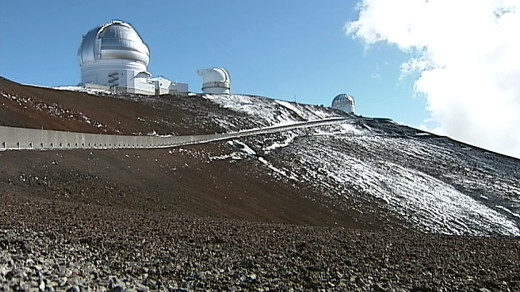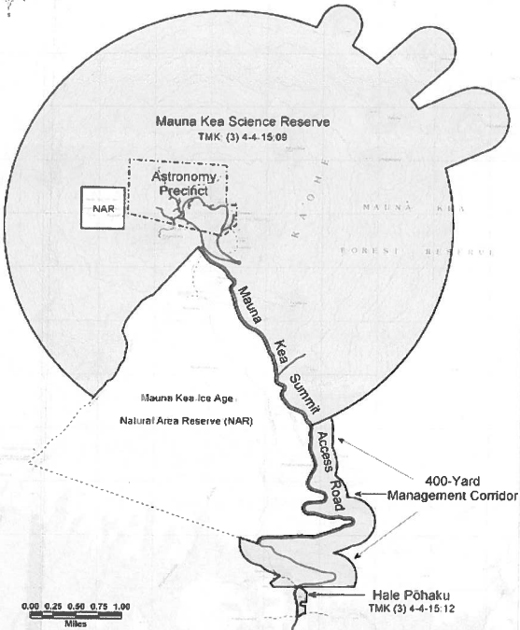MAUNA KEA, Hawaii – A new lease for the summit area of Mauna Kea could replace the current lease, two decades before it expires, putting the sacred summit in the hands of the University of Hawaii until 2078. The action has been agendized for the land board meeting this Friday (Nov. 8) in Honolulu.
Three parcels, all zoned conservation, are currently leased by UH. They are the 11,215 acre Mauna Kea Science Reserve (MKSR), the 19.2 acre Hale Pohaku Mid-Level Facility, and the Access Road between Hale Pohaku and the MKSR.
The Mauna Kea Science Reserve was established in 1968. The Board of Land and Natural Resources has ultimate authority over the area, but it has delegated certain management responsibilities to the University of Hawaii. In 2009, the BLNR approved the Mauna Kea Comprehensive Management Plan (CMP), which details how UH will manage the summit area. The university has also developed subplans to go with the CMP – a Cultural Resources Management Plan, Natural Resources Management Plan, Public Access Plan, and a Decommissioning Plan for the observatories that occupy the summit.
Mauna Kea CMP approval – 2009 (Part 1)
Mauna Kea CMP approval – 2009 (Part 2)
The lease for the access road and the Mauna Kea Science Reserve was set to expire on December 31, 2033. The lease for Hale Pohaku ends on February 28, 2041.
The land board tallies eight optical and/or infrared observatories in the MKSR’s 525-acre Astronomy Precinct. The board has also approved a conservation district use permit for the Thirty Meter Telescope.
In August, the UH Board of Regents requested the mutual cancellation of the existing leases on the mountain, to be replaced by a new, 65 year lease. The reasons UH gave for the requests, according to BLNR documents:
| 1) the need to address internal changes made by the UH in how it manages lands on Mauna Kea; 2) the need to reflect management actions and reporting requirements adopted by the Board of Land and Natural Resources; 3) to assist in implementing legislation concerning the Mauna Kea lands managed by UH; and 4) to provide the basis for developing sublease agreements with current and … any potential future telescope projects. |
The Office of Mauna Kea Management (OMKM) – established under the MKSR Master Plan, adopted in June 2000 – has offered some examples of what it considers to be success stories “that underscore the importance of conservation management plans”. Most recently, OMKM issued a media release on the rare Wēkiu bug, which was once listed for as a candidate for Federal protection, but has now been removed from the list by the US Fish & Wildlife Service under the Endangered Species Act.
From the OMKM media release:
| The Federal report stated, “The removal of the Wēkiu bug is based on the successful management of the summit of Mauna Kea on the island of Hawai‘i. Survey work resulted in more than doubling the number of sites where the species is found. The protection and monitoring of the Wēkiu bug provided through the management plans for Mauna Kea has precluded the need to list this species.”
Throughout its decade of management, the Office of Mauna Kea Management (OMKM) has worked collaboratively with State and Federal agencies to ensure proper management and protection of various flora and fauna species on Mauna Kea including the Wēkiu bug. The Mauna Kea Comprehensive Management Plan is the roadmap that guides the Office of Mauna Kea Management. |
But there will be loud voices of opposition to the proposed new lease.
KAHEA, The Hawaiian-Environmental Alliance, is urging the public to take action to “Stop the University’s Mismanagement of Mauna Kea!” The organization recently wrote:
| BLNR’s proposed lease is troubling for at least three reasons:
First, UH has been a terrible lessee. As the state auditor concluded in 1998, UH has pursued telescope observatory development at the expense of protecting Mauna Kea. Not much has changed since 1998. In May 2013, UH announced plans to expand parking and visitor areas, which facilitates more traffic and activity in Mauna Kea’s fragile ecosystem. UH has yet to implement protections against invasive species, burial treatment plans, or to even develop decommissioning plans for existing telescopes. Second, BLNR is proposing to exempt this lease from environmental impact review, in part by relying on an “environmental analysis” in UH’s Comprehensive Management Plan (CMP). Substituting the CMP for comprehensive environmental review is a bad idea because the CMP: (1) lacks enforceable timelines for studies and future plans – including any plans for future development, such as the Thirty-Meter Telescope (TMT); and (2) it is not comprehensive because it only applies to “UH Management Areas” – as opposed to the whole of Mauna Kea’s natural, cultural, and historic property resources. The CMP is a “plan to plan” but does not disclose the full environmental (and cultural) impacts of re-leasing Mauna Kea to UH for another generation’s lifetime. Third, BLNR proposes that existing subleases continue in “full force” until 2033, which includes failing to require sublessee telescope operators to pay fair market rent. While no value for rent has been determined, in 2009, for instance, Keck Observatory entered an agreement in which Yale University would pay $12 million for 15 nights for 10 years, or $80,000 per night. In 1998, the state auditor concluded,“[UH] was more concerned about the benefits to its research program than about monetary consideration for the state… All sublease to operators were gratis [free] or for a token $1.00.” Under BLNR’s proposed lease, UH can continue to rent public resources to private telescope operators – trading the desecration of Mauna Kea to observatory operators for a dollar per year in rent or less. |
As of the time of this story’s posting, a petition to “Protect Mauna Kea: Stop Further Development and Stop the University of Hawaii’s Lease Renewal for Mauna Kea’s Public Lands!” started by Shae Kamakaala had 233 signatures out of a goal of 300.



by Big Island Video News10:36 pm
on at
STORY SUMMARY
MAUNA KEA, Hawaii – A new lease for the summit area of Mauna Kea could replace the current lease, two decades before it expires, putting the sacred summit in the hands of the University of Hawaii until 2078. The action has been agendized for the land board meeting this Friday (Nov. 8) in Honolulu. Three […]